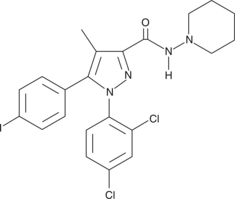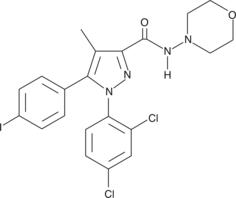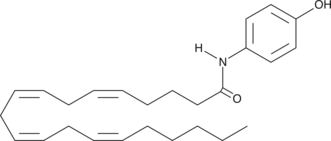Cayman
Showing 9151–9300 of 45550 results
-
Aloin is a mixture of aloin A and aloin B (Item No. 23321), anthraquinones found in Aloe vera, and has diverse biological activities.{36960,36961,36962} It reduces IL-6 and TNF-α expression as well as nitric oxide (NO) production and COX-2 and inducible NO synthase (iNOS) expression in LPS-stimulated RAW 264.7 cells when used at concentrations ranging from 100 to 400 mM.{36960} Aloin inhibits LPS-induced p65 acetylation, nuclear translocation of NF-kB, and apoptosis in RAW 264.7 cells. It reduces motility of T. congolense in vitro and reduces the number of parasites in T. congolense-infected mice when administered at a dose of 400 mg/kg.{36961} Aloin (50 and 100 mg/kg) also reduces activity of glutathione peroxidase (GPX), glutathione-S-transferase (GST), and glutathione reductase (GR), the level of colonic malondialdehyde (MDA), and the number of aberrant crypt foci and mucin-depleted foci in a rat model of 1,2-dimethylhydrazine-induced colon cancer.{36962}
Brand:CaymanSKU:22435 -Out of stock
-
Aloin is a mixture of aloin A and aloin B (Item No. 23321), anthraquinones found in Aloe vera, and has diverse biological activities.{36960,36961,36962} It reduces IL-6 and TNF-α expression as well as nitric oxide (NO) production and COX-2 and inducible NO synthase (iNOS) expression in LPS-stimulated RAW 264.7 cells when used at concentrations ranging from 100 to 400 mM.{36960} Aloin inhibits LPS-induced p65 acetylation, nuclear translocation of NF-kB, and apoptosis in RAW 264.7 cells. It reduces motility of T. congolense in vitro and reduces the number of parasites in T. congolense-infected mice when administered at a dose of 400 mg/kg.{36961} Aloin (50 and 100 mg/kg) also reduces activity of glutathione peroxidase (GPX), glutathione-S-transferase (GST), and glutathione reductase (GR), the level of colonic malondialdehyde (MDA), and the number of aberrant crypt foci and mucin-depleted foci in a rat model of 1,2-dimethylhydrazine-induced colon cancer.{36962}
Brand:CaymanSKU:22435 -Out of stock
-
Aloin is a mixture of aloin A and aloin B (Item No. 23321), anthraquinones found in Aloe vera, and has diverse biological activities.{36960,36961,36962} It reduces IL-6 and TNF-α expression as well as nitric oxide (NO) production and COX-2 and inducible NO synthase (iNOS) expression in LPS-stimulated RAW 264.7 cells when used at concentrations ranging from 100 to 400 mM.{36960} Aloin inhibits LPS-induced p65 acetylation, nuclear translocation of NF-kB, and apoptosis in RAW 264.7 cells. It reduces motility of T. congolense in vitro and reduces the number of parasites in T. congolense-infected mice when administered at a dose of 400 mg/kg.{36961} Aloin (50 and 100 mg/kg) also reduces activity of glutathione peroxidase (GPX), glutathione-S-transferase (GST), and glutathione reductase (GR), the level of colonic malondialdehyde (MDA), and the number of aberrant crypt foci and mucin-depleted foci in a rat model of 1,2-dimethylhydrazine-induced colon cancer.{36962}
Brand:CaymanSKU:22435 -Out of stock
-
Aloin B is an anthraquinone found in Aloe vera and a component of racemic aloin (Item No. 22435).{47080}
Brand:CaymanSKU:23321 - 1 mgAvailable on backorder
-
Aloin B is an anthraquinone found in Aloe vera and a component of racemic aloin (Item No. 22435).{47080}
Brand:CaymanSKU:23321 - 10 mgAvailable on backorder
-
Aloin B is an anthraquinone found in Aloe vera and a component of racemic aloin (Item No. 22435).{47080}
Brand:CaymanSKU:23321 - 25 mgAvailable on backorder
-
Aloin B is an anthraquinone found in Aloe vera and a component of racemic aloin (Item No. 22435).{47080}
Brand:CaymanSKU:23321 - 5 mgAvailable on backorder
-
Aloisine is an inhibitor of Cdk1/cyclin B, Cdk5/p25, and GSK3 (IC50s = 0.70, 1.5, and 0.92 µM, respectively).{38576} It is a derivative of the aloisines A and B, which competitively inhibit ATP binding to the catalytic subunit of CDKs and GSKs.
Brand:CaymanSKU:21873 -Out of stock
-
Aloisine is an inhibitor of Cdk1/cyclin B, Cdk5/p25, and GSK3 (IC50s = 0.70, 1.5, and 0.92 µM, respectively).{38576} It is a derivative of the aloisines A and B, which competitively inhibit ATP binding to the catalytic subunit of CDKs and GSKs.
Brand:CaymanSKU:21873 -Out of stock
-
Aloisine is an inhibitor of Cdk1/cyclin B, Cdk5/p25, and GSK3 (IC50s = 0.70, 1.5, and 0.92 µM, respectively).{38576} It is a derivative of the aloisines A and B, which competitively inhibit ATP binding to the catalytic subunit of CDKs and GSKs.
Brand:CaymanSKU:21873 -Out of stock
-
Aloisine is an inhibitor of Cdk1/cyclin B, Cdk5/p25, and GSK3 (IC50s = 0.70, 1.5, and 0.92 µM, respectively).{38576} It is a derivative of the aloisines A and B, which competitively inhibit ATP binding to the catalytic subunit of CDKs and GSKs.
Brand:CaymanSKU:21873 -Out of stock
-
Aloperine is an alkaloid found in the roots of S. flavescens with diverse biological activities including antiviral, anticancer, antioxidant, and anti-inflammatory actions.{39317,39318,39319,39320} It inhibits HIV-1 replication and envelope-mediated cell-cell fusion (EC50s = 1.75 and 1.2 μM, respectively) at concentrations well below the cytotoxic concentration (CC50) of >86.5 μM in vitro.{39317} Aloperine inhibits the growth of HL-60, U937, and K562 leukemia cell lines with IC50 values of 40, 270, and 360 μM, respectively.{39318} Administration of aloperine, at a dose of 60 mg/kg, reduces NOX2, NOX4, superoxide dismutase, and glutathione peroxidase expression in lungs in a rat model of pulmonary hypertension.{39319} Topical administration of aloperine reduces ear swelling, ear erythema, and production of inflammatory cytokines TNF-α, IL-1β, and IL-6 in a mouse model of allergic contact dermatitis.{39320}
Brand:CaymanSKU:22259 -Out of stock
-
Aloperine is an alkaloid found in the roots of S. flavescens with diverse biological activities including antiviral, anticancer, antioxidant, and anti-inflammatory actions.{39317,39318,39319,39320} It inhibits HIV-1 replication and envelope-mediated cell-cell fusion (EC50s = 1.75 and 1.2 μM, respectively) at concentrations well below the cytotoxic concentration (CC50) of >86.5 μM in vitro.{39317} Aloperine inhibits the growth of HL-60, U937, and K562 leukemia cell lines with IC50 values of 40, 270, and 360 μM, respectively.{39318} Administration of aloperine, at a dose of 60 mg/kg, reduces NOX2, NOX4, superoxide dismutase, and glutathione peroxidase expression in lungs in a rat model of pulmonary hypertension.{39319} Topical administration of aloperine reduces ear swelling, ear erythema, and production of inflammatory cytokines TNF-α, IL-1β, and IL-6 in a mouse model of allergic contact dermatitis.{39320}
Brand:CaymanSKU:22259 -Out of stock
-
Alosetron is a potent and selective antagonist of the serotonin (5-HT) receptor subtype 5-HT3 with Ki values of 0.3 and 0.4 nM at the rat cortical and human recombinant receptors, respectively.{39117} It has no activity at α1-, β1-, and β2- adrenergic, M1, M2, and M3 muscarinic, GABAA, D2 dopamine, or nicotinic receptors at concentrations up to 10 μM.{39120} In vitro, alosetron blocks activation of 5-HT3 receptors, which prevents depolarization of the isolated rat vagus nerve (Ki = 0.2 nM). Alosetron (0.1 mg/kg) reduces wrap restraint stress-induced defecation and the number of abdominal muscle contractions in a rat model of irritable bowel syndrome with diarrhea (IBS-D).{39118} Formulations containing alosetron are in clinical trials for treatment of severe IBS-D in women.{39119}
Brand:CaymanSKU:22434 -Out of stock
-
Alosetron is a potent and selective antagonist of the serotonin (5-HT) receptor subtype 5-HT3 with Ki values of 0.3 and 0.4 nM at the rat cortical and human recombinant receptors, respectively.{39117} It has no activity at α1-, β1-, and β2- adrenergic, M1, M2, and M3 muscarinic, GABAA, D2 dopamine, or nicotinic receptors at concentrations up to 10 μM.{39120} In vitro, alosetron blocks activation of 5-HT3 receptors, which prevents depolarization of the isolated rat vagus nerve (Ki = 0.2 nM). Alosetron (0.1 mg/kg) reduces wrap restraint stress-induced defecation and the number of abdominal muscle contractions in a rat model of irritable bowel syndrome with diarrhea (IBS-D).{39118} Formulations containing alosetron are in clinical trials for treatment of severe IBS-D in women.{39119}
Brand:CaymanSKU:22434 -Out of stock
-
Alosetron is a potent and selective antagonist of the serotonin (5-HT) receptor subtype 5-HT3 with Ki values of 0.3 and 0.4 nM at the rat cortical and human recombinant receptors, respectively.{39117} It has no activity at α1-, β1-, and β2- adrenergic, M1, M2, and M3 muscarinic, GABAA, D2 dopamine, or nicotinic receptors at concentrations up to 10 μM.{39120} In vitro, alosetron blocks activation of 5-HT3 receptors, which prevents depolarization of the isolated rat vagus nerve (Ki = 0.2 nM). Alosetron (0.1 mg/kg) reduces wrap restraint stress-induced defecation and the number of abdominal muscle contractions in a rat model of irritable bowel syndrome with diarrhea (IBS-D).{39118} Formulations containing alosetron are in clinical trials for treatment of severe IBS-D in women.{39119}
Brand:CaymanSKU:22434 -Out of stock
-
Alosetron is a potent and selective antagonist of the serotonin (5-HT) receptor subtype 5-HT3 with Ki values of 0.3 and 0.4 nM at the rat cortical and human recombinant receptors, respectively.{39117} It has no activity at α1-, β1-, and β2- adrenergic, M1, M2, and M3 muscarinic, GABAA, D2 dopamine, or nicotinic receptors at concentrations up to 10 μM.{39120} In vitro, alosetron blocks activation of 5-HT3 receptors, which prevents depolarization of the isolated rat vagus nerve (Ki = 0.2 nM). Alosetron (0.1 mg/kg) reduces wrap restraint stress-induced defecation and the number of abdominal muscle contractions in a rat model of irritable bowel syndrome with diarrhea (IBS-D).{39118} Formulations containing alosetron are in clinical trials for treatment of severe IBS-D in women.{39119}
Brand:CaymanSKU:22434 -Out of stock
-
ALP Assay Buffer has been tested and formulated to work exclusively with Cayman’s Alkaline Phosphatase Colorimetric Activity Assay Kit (Item No. 701710). Please visit Alkaline Phosphatase Colorimetric Activity Assay Kit (Item No. 701710) for the kit protocol, procedures, and product handling.
Brand:CaymanSKU:400083 - 30 mlAvailable on backorder
-
Alphitonin is a flavonoid that has been found in L. leptolepis wood.{49485} It is also a metabolic intermediate that is formed during the catabolism of quercetin (Item No. 10005169) by the human gut bacteria E. ramulus.{49483,49484}
Brand:CaymanSKU:29716 - 1 mgAvailable on backorder
-
Alphitonin is a flavonoid that has been found in L. leptolepis wood.{49485} It is also a metabolic intermediate that is formed during the catabolism of quercetin (Item No. 10005169) by the human gut bacteria E. ramulus.{49483,49484}
Brand:CaymanSKU:29716 - 5 mgAvailable on backorder
-
Alprazolam-d3 (exempt preparation) (Item No. 23784) is intended for use as an internal standard for the quantification of alprazolam (Item No. ISO60185) by GC- or LC-MS. Alprazolam is categorized as a benzodiazepine.{25991} Alprazolam is regulated as a Schedule IV compound in the United States. Alprazolam-d3 (exempt preparation) (Item No. 23784) is provided as a DEA exempt preparation. This product is intended for research and forensic applications.
Brand:CaymanSKU:23784 - 100 µgAvailable on backorder
-
Alprenolol is a non-selective β-adrenergic receptor (β-AR) antagonist that is also an antagonist of the serotonin (5-HT) receptor subtypes 5-HT1A and 5-HT1B.{25151,41186} It binds to β1-, β2-, and β3-ARs expressed in CHO cells (Kds = 15, 0.91, and 117 nM, respectively, for the human receptors) and to 5-HT1A and 5-HT1B receptors in rat hippocampal and striatal membranes (Kis = 34 and 134 nM, respectively).{25151,41186} In vivo, alprenolol (40 mg/kg, i.v.) completely blocks the hyperactivity response of rats to 2-PCPA (Item No. 10010494) and L-tryptophan.{25891} Alprenolol (10 μg, i.v.) inhibits decreases in heart rate and left ventricular systolic pressure induced by the β2-AR antagonist ICI 118551 (Item No. 15591) in transgenic mice overexpressing the β2-AR.{36710} It also reduces the level of abnormal prion fibrils (PrPSc) in the brain of mice intracerebrally infected with prion disease to less than 20% of control levels when administered in drinking water at a dose of 50 mg/L.{36711}
Brand:CaymanSKU:25338 - 100 mgAvailable on backorder
-
Alprenolol is a non-selective β-adrenergic receptor (β-AR) antagonist that is also an antagonist of the serotonin (5-HT) receptor subtypes 5-HT1A and 5-HT1B.{25151,41186} It binds to β1-, β2-, and β3-ARs expressed in CHO cells (Kds = 15, 0.91, and 117 nM, respectively, for the human receptors) and to 5-HT1A and 5-HT1B receptors in rat hippocampal and striatal membranes (Kis = 34 and 134 nM, respectively).{25151,41186} In vivo, alprenolol (40 mg/kg, i.v.) completely blocks the hyperactivity response of rats to 2-PCPA (Item No. 10010494) and L-tryptophan.{25891} Alprenolol (10 μg, i.v.) inhibits decreases in heart rate and left ventricular systolic pressure induced by the β2-AR antagonist ICI 118551 (Item No. 15591) in transgenic mice overexpressing the β2-AR.{36710} It also reduces the level of abnormal prion fibrils (PrPSc) in the brain of mice intracerebrally infected with prion disease to less than 20% of control levels when administered in drinking water at a dose of 50 mg/L.{36711}
Brand:CaymanSKU:25338 - 25 mgAvailable on backorder
-
Alprenolol is a non-selective β-adrenergic receptor (β-AR) antagonist that is also an antagonist of the serotonin (5-HT) receptor subtypes 5-HT1A and 5-HT1B.{25151,41186} It binds to β1-, β2-, and β3-ARs expressed in CHO cells (Kds = 15, 0.91, and 117 nM, respectively, for the human receptors) and to 5-HT1A and 5-HT1B receptors in rat hippocampal and striatal membranes (Kis = 34 and 134 nM, respectively).{25151,41186} In vivo, alprenolol (40 mg/kg, i.v.) completely blocks the hyperactivity response of rats to 2-PCPA (Item No. 10010494) and L-tryptophan.{25891} Alprenolol (10 μg, i.v.) inhibits decreases in heart rate and left ventricular systolic pressure induced by the β2-AR antagonist ICI 118551 (Item No. 15591) in transgenic mice overexpressing the β2-AR.{36710} It also reduces the level of abnormal prion fibrils (PrPSc) in the brain of mice intracerebrally infected with prion disease to less than 20% of control levels when administered in drinking water at a dose of 50 mg/L.{36711}
Brand:CaymanSKU:25338 - 50 mgAvailable on backorder
-
Alrestatin is an inhibitor of aldose reductase (IC50 = 1.5 µM for rat lens enzyme).{52459} It is selective for rat lens aldose reductase over rat kidney aldehyde reductase (IC50 = 58 µM). Alrestatin reduces basal and tyramine-induced norepinephrine release in rat pancreatic preparations.{52458} In vivo, alrestatin (0.75 mmol/kg) increases plasma insulin levels in fasted anesthetized rats. Alrestatin inhibits the lens and sciatic nerve accumulation of polyols in a rat model of streptozotocin-induced diabetes.{52460} It also inhibits gastric acid secretion and ulcer formation induced by pyloric ligation in rats (ED50s = 90 and 330 mg/kg, respectively).
Brand:CaymanSKU:29888 - 10 mgAvailable on backorder
-
Alrestatin is an inhibitor of aldose reductase (IC50 = 1.5 µM for rat lens enzyme).{52459} It is selective for rat lens aldose reductase over rat kidney aldehyde reductase (IC50 = 58 µM). Alrestatin reduces basal and tyramine-induced norepinephrine release in rat pancreatic preparations.{52458} In vivo, alrestatin (0.75 mmol/kg) increases plasma insulin levels in fasted anesthetized rats. Alrestatin inhibits the lens and sciatic nerve accumulation of polyols in a rat model of streptozotocin-induced diabetes.{52460} It also inhibits gastric acid secretion and ulcer formation induced by pyloric ligation in rats (ED50s = 90 and 330 mg/kg, respectively).
Brand:CaymanSKU:29888 - 25 mgAvailable on backorder
-
Alrestatin is an inhibitor of aldose reductase (IC50 = 1.5 µM for rat lens enzyme).{52459} It is selective for rat lens aldose reductase over rat kidney aldehyde reductase (IC50 = 58 µM). Alrestatin reduces basal and tyramine-induced norepinephrine release in rat pancreatic preparations.{52458} In vivo, alrestatin (0.75 mmol/kg) increases plasma insulin levels in fasted anesthetized rats. Alrestatin inhibits the lens and sciatic nerve accumulation of polyols in a rat model of streptozotocin-induced diabetes.{52460} It also inhibits gastric acid secretion and ulcer formation induced by pyloric ligation in rats (ED50s = 90 and 330 mg/kg, respectively).
Brand:CaymanSKU:29888 - 5 mgAvailable on backorder
-
Alrestatin is an inhibitor of aldose reductase (IC50 = 1.5 µM for rat lens enzyme).{52459} It is selective for rat lens aldose reductase over rat kidney aldehyde reductase (IC50 = 58 µM). Alrestatin reduces basal and tyramine-induced norepinephrine release in rat pancreatic preparations.{52458} In vivo, alrestatin (0.75 mmol/kg) increases plasma insulin levels in fasted anesthetized rats. Alrestatin inhibits the lens and sciatic nerve accumulation of polyols in a rat model of streptozotocin-induced diabetes.{52460} It also inhibits gastric acid secretion and ulcer formation induced by pyloric ligation in rats (ED50s = 90 and 330 mg/kg, respectively).
Brand:CaymanSKU:29888 - 50 mgAvailable on backorder
-
Alsterpaullone is a derivative of kenpaullone (Item No. 10010239), an ATP-competitive inhibitor of several cyclin-dependent kinases (CDKs) as well as glycogen synthase kinase 3β (GSK3β). With slightly improved potency over kenpaullone, alsterpaullone selectively inhibits Cdk1/cyclin B, Cdk2/cyclin A, Cdk2/cyclin E, Cdk5/p25, and GSK3α/β with IC50 values of 35, 15, 200, 40, and 4 nM, respectively.{22493,14995} Alsterpaullone has been used to inhibit the cytosolic degradation of β-catenin to alter the canonical Wnt signaling pathway in primary axis patterning, to reduce tau phosphorylation in an effort to modify neuropathological events associated with Alzheimer’s disease, and to alter cell proliferation or protein expression in various diseases.{22492,22495,22494}
Brand:CaymanSKU:- -
Alsterpaullone is a derivative of kenpaullone (Item No. 10010239), an ATP-competitive inhibitor of several cyclin-dependent kinases (CDKs) as well as glycogen synthase kinase 3β (GSK3β). With slightly improved potency over kenpaullone, alsterpaullone selectively inhibits Cdk1/cyclin B, Cdk2/cyclin A, Cdk2/cyclin E, Cdk5/p25, and GSK3α/β with IC50 values of 35, 15, 200, 40, and 4 nM, respectively.{22493,14995} Alsterpaullone has been used to inhibit the cytosolic degradation of β-catenin to alter the canonical Wnt signaling pathway in primary axis patterning, to reduce tau phosphorylation in an effort to modify neuropathological events associated with Alzheimer’s disease, and to alter cell proliferation or protein expression in various diseases.{22492,22495,22494}
Brand:CaymanSKU:- -
Brand:CaymanSKU:700261 - 1 ea
Available on backorder
-
-
-
Brand:CaymanSKU:700265 - 1 ea
Available on backorder
-
-
Altenusin is a polyphenol fungal metabolite originally isolated from the fungus Alternaria that has diverse biological activities.{47219,47220} It inhibits Src kinase with an IC50 value of 20 nM.{47221} Altenusin inhibits fibrillization of recombinant tau fragments in vitro and phosphorylation of tau in SH-SY5Y cells expressing human P301L mutant tau when used at a concentration of 10 μM.{47219} It is an agonist of the farnesoid X receptor (FXR; EC50 = 3.2 μM) that reduces blood glucose, serum insulin, and serum cholesterol levels, as well as hepatic lipogenic gene expression and steatosis, in a high fat diet-induced mouse model of obesity when administered at 30 mg/kg per day.{47220} Altenusin also has antioxidant and antifungal properties.
Brand:CaymanSKU:26911 - 1 mgAvailable on backorder
-
Altenusin is a polyphenol fungal metabolite originally isolated from the fungus Alternaria that has diverse biological activities.{47219,47220} It inhibits Src kinase with an IC50 value of 20 nM.{47221} Altenusin inhibits fibrillization of recombinant tau fragments in vitro and phosphorylation of tau in SH-SY5Y cells expressing human P301L mutant tau when used at a concentration of 10 μM.{47219} It is an agonist of the farnesoid X receptor (FXR; EC50 = 3.2 μM) that reduces blood glucose, serum insulin, and serum cholesterol levels, as well as hepatic lipogenic gene expression and steatosis, in a high fat diet-induced mouse model of obesity when administered at 30 mg/kg per day.{47220} Altenusin also has antioxidant and antifungal properties.
Brand:CaymanSKU:26911 - 5 mgAvailable on backorder
-
Altenusin is a polyphenol fungal metabolite originally isolated from the fungus Alternaria that has diverse biological activities.{47219,47220} It inhibits Src kinase with an IC50 value of 20 nM.{47221} Altenusin inhibits fibrillization of recombinant tau fragments in vitro and phosphorylation of tau in SH-SY5Y cells expressing human P301L mutant tau when used at a concentration of 10 μM.{47219} It is an agonist of the farnesoid X receptor (FXR; EC50 = 3.2 μM) that reduces blood glucose, serum insulin, and serum cholesterol levels, as well as hepatic lipogenic gene expression and steatosis, in a high fat diet-induced mouse model of obesity when administered at 30 mg/kg per day.{47220} Altenusin also has antioxidant and antifungal properties.
Brand:CaymanSKU:26911 - 500 µgAvailable on backorder
-
Alternariol is a mycotoxin, a toxic secondary fungal metabolite, produced by Alternaria molds. It is cytotoxic, fetotoxic, teratogenic, mutagenic, and genotoxic.{20385} It induces cytochrome P450 1A1 expression and apoptosis in mouse hepatoma cells (20-40 μM).{20386} Alternariol, whose synthesis is inhibited by light, naturally occurs on fruits, vegetables, and cereals, such as apples, tomatoes, and wheat.{20387}
Brand:CaymanSKU:11306 - 1 mgAvailable on backorder
-
Alternariol is a mycotoxin, a toxic secondary fungal metabolite, produced by Alternaria molds. It is cytotoxic, fetotoxic, teratogenic, mutagenic, and genotoxic.{20385} It induces cytochrome P450 1A1 expression and apoptosis in mouse hepatoma cells (20-40 μM).{20386} Alternariol, whose synthesis is inhibited by light, naturally occurs on fruits, vegetables, and cereals, such as apples, tomatoes, and wheat.{20387}
Brand:CaymanSKU:11306 - 5 mgAvailable on backorder
-
Alternariol monomethyl ether (AME) is a mycotoxin originally isolated from A. brassicae extracts. AME is a common contaminant in cereal grains such as wheat, barley, and sorghum that is cytotoxic to bacterial (MIC = 500 μg/disc for B. mycoides in a bacterial halo assay) and mammalian cells (IC50 = 120 μM in HCT116 cells).{38070,38071} It inhibits human topoisomerase II and bacterial gyrase at initial inhibitory concentrations of 25 and 10 μM, respectively. AME selectively inhibits monoamine oxidase A (MOA-A; Ki = 0.34 μM).{33238,38072} AME also provokes DNA damage that induces mitochondrial permeability transition pore-mediated activation of apoptosis.{38071}
Brand:CaymanSKU:11307 - 1 mgAvailable on backorder
-
Alternariol monomethyl ether (AME) is a mycotoxin originally isolated from A. brassicae extracts. AME is a common contaminant in cereal grains such as wheat, barley, and sorghum that is cytotoxic to bacterial (MIC = 500 μg/disc for B. mycoides in a bacterial halo assay) and mammalian cells (IC50 = 120 μM in HCT116 cells).{38070,38071} It inhibits human topoisomerase II and bacterial gyrase at initial inhibitory concentrations of 25 and 10 μM, respectively. AME selectively inhibits monoamine oxidase A (MOA-A; Ki = 0.34 μM).{33238,38072} AME also provokes DNA damage that induces mitochondrial permeability transition pore-mediated activation of apoptosis.{38071}
Brand:CaymanSKU:11307 - 5 mgAvailable on backorder
-
Altertoxin I is a natural mycotoxin first isolated from fungi of the genus Alternaria. It is a hydroxyperylenequinone that shows mutagenic activity against S. typhimurium and inhibits human topoisomerase II and bacterial gyrase.{33238,33239} Altertoxin I completely inhibits replication of HIV-1 virus at 2.2 µM in a cell-based assay.{33237}
Brand:CaymanSKU:21129 -Out of stock
-
Altertoxin I is a natural mycotoxin first isolated from fungi of the genus Alternaria. It is a hydroxyperylenequinone that shows mutagenic activity against S. typhimurium and inhibits human topoisomerase II and bacterial gyrase.{33238,33239} Altertoxin I completely inhibits replication of HIV-1 virus at 2.2 µM in a cell-based assay.{33237}
Brand:CaymanSKU:21129 -Out of stock
-
Altiratinib is a multiple kinase inhibitor, blocking Met, Tie2, VEGF2, TrkA, TrkB, and TrkC with IC50 values of 2.7, 8.0, 9.2, 0.85, 4.6, and 0.83 nM, respectively.{32781} It also inhibits several mutant Met isoforms at nanomolar concentrations. Altiratinib inhibits the proliferation of several cancer cell lines in vitro and blocks capillary tube formation by HMVEC cells.{32781} It is orally bioavailable and penetrates the blood brain barrier, suppressing the growth of subcutaneous and intracerebroventricular xenograft tumors in mice.{32781,32780}
Brand:CaymanSKU:-Available on backorder
-
Altiratinib is a multiple kinase inhibitor, blocking Met, Tie2, VEGF2, TrkA, TrkB, and TrkC with IC50 values of 2.7, 8.0, 9.2, 0.85, 4.6, and 0.83 nM, respectively.{32781} It also inhibits several mutant Met isoforms at nanomolar concentrations. Altiratinib inhibits the proliferation of several cancer cell lines in vitro and blocks capillary tube formation by HMVEC cells.{32781} It is orally bioavailable and penetrates the blood brain barrier, suppressing the growth of subcutaneous and intracerebroventricular xenograft tumors in mice.{32781,32780}
Brand:CaymanSKU:-Available on backorder
-
Altiratinib is a multiple kinase inhibitor, blocking Met, Tie2, VEGF2, TrkA, TrkB, and TrkC with IC50 values of 2.7, 8.0, 9.2, 0.85, 4.6, and 0.83 nM, respectively.{32781} It also inhibits several mutant Met isoforms at nanomolar concentrations. Altiratinib inhibits the proliferation of several cancer cell lines in vitro and blocks capillary tube formation by HMVEC cells.{32781} It is orally bioavailable and penetrates the blood brain barrier, suppressing the growth of subcutaneous and intracerebroventricular xenograft tumors in mice.{32781,32780}
Brand:CaymanSKU:-Available on backorder
-
Altiratinib is a multiple kinase inhibitor, blocking Met, Tie2, VEGF2, TrkA, TrkB, and TrkC with IC50 values of 2.7, 8.0, 9.2, 0.85, 4.6, and 0.83 nM, respectively.{32781} It also inhibits several mutant Met isoforms at nanomolar concentrations. Altiratinib inhibits the proliferation of several cancer cell lines in vitro and blocks capillary tube formation by HMVEC cells.{32781} It is orally bioavailable and penetrates the blood brain barrier, suppressing the growth of subcutaneous and intracerebroventricular xenograft tumors in mice.{32781,32780}
Brand:CaymanSKU:-Available on backorder
-
Altrenogest is a synthetic progestin and an agonist of progesterone and androgen receptors (EC50s = 0.64 and 0.63 nM, respectively, in S. cerevisiae cells expressing human receptors).{40099} In vivo, altrenogest (20 mg/animal per day) reduces testicular weight, sperm content, and serum levels of luteinizing hormone and testosterone in boars.{47440} Altrenogest (0.044 mg/kg) increases serum concentrations of equine chorionic gonadotropin and embryonic size in pregnant mares.{47441} It also decreases genital perfusion and increases estrus cycle length in mares.{47442} Formulations containing altrenogest have been used to synchronize estrus in horses and pigs.
Brand:CaymanSKU:27218 - 1 gAvailable on backorder
-
Altrenogest is a synthetic progestin and an agonist of progesterone and androgen receptors (EC50s = 0.64 and 0.63 nM, respectively, in S. cerevisiae cells expressing human receptors).{40099} In vivo, altrenogest (20 mg/animal per day) reduces testicular weight, sperm content, and serum levels of luteinizing hormone and testosterone in boars.{47440} Altrenogest (0.044 mg/kg) increases serum concentrations of equine chorionic gonadotropin and embryonic size in pregnant mares.{47441} It also decreases genital perfusion and increases estrus cycle length in mares.{47442} Formulations containing altrenogest have been used to synchronize estrus in horses and pigs.
Brand:CaymanSKU:27218 - 250 mgAvailable on backorder
-
Altrenogest is a synthetic progestin and an agonist of progesterone and androgen receptors (EC50s = 0.64 and 0.63 nM, respectively, in S. cerevisiae cells expressing human receptors).{40099} In vivo, altrenogest (20 mg/animal per day) reduces testicular weight, sperm content, and serum levels of luteinizing hormone and testosterone in boars.{47440} Altrenogest (0.044 mg/kg) increases serum concentrations of equine chorionic gonadotropin and embryonic size in pregnant mares.{47441} It also decreases genital perfusion and increases estrus cycle length in mares.{47442} Formulations containing altrenogest have been used to synchronize estrus in horses and pigs.
Brand:CaymanSKU:27218 - 500 mgAvailable on backorder
-
Altretamine is an antineoplastic agent with antiproliferative activity.{41191} It induces cytotoxicity in an ovarian cancer cell line when used at a concentration of 10 μg/ml, with radiolabeled thymidine uptake equal to 102 and 75% of controls after 48 and 120 hours, respectively.{41189} Altretamine (100 μg/ml) reduces colony survival in A204 human rhabdomyosarcoma cells in an NADP-dependent manner in the presence of an S-9 hepatic activating mixture.{41190} In vivo, altretamine (150 mg/kg) reduces tumor growth in a mouse model of M5076 murine reticulum cell sarcoma.{41191} Altretamine (0.5 mM) inhibits glutathione peroxidase 4 (GPX4) and induces accumulation of lipid-reactive oxygen species (ROS) in U-2932 cells without depleting glutathione (GSH) levels, suggesting it is a class II ferroptosis-inducing compound (FIN).{47408} It also acts as a chemosterilant in houseflies, preventing hatching and pupation in male and female houseflies when used at a concentration of 0.05%.{41192} Formulations of altretamine have been used in the treatment of various cancers.
Brand:CaymanSKU:23662 - 100 mgAvailable on backorder
-
Altretamine is an antineoplastic agent with antiproliferative activity.{41191} It induces cytotoxicity in an ovarian cancer cell line when used at a concentration of 10 μg/ml, with radiolabeled thymidine uptake equal to 102 and 75% of controls after 48 and 120 hours, respectively.{41189} Altretamine (100 μg/ml) reduces colony survival in A204 human rhabdomyosarcoma cells in an NADP-dependent manner in the presence of an S-9 hepatic activating mixture.{41190} In vivo, altretamine (150 mg/kg) reduces tumor growth in a mouse model of M5076 murine reticulum cell sarcoma.{41191} Altretamine (0.5 mM) inhibits glutathione peroxidase 4 (GPX4) and induces accumulation of lipid-reactive oxygen species (ROS) in U-2932 cells without depleting glutathione (GSH) levels, suggesting it is a class II ferroptosis-inducing compound (FIN).{47408} It also acts as a chemosterilant in houseflies, preventing hatching and pupation in male and female houseflies when used at a concentration of 0.05%.{41192} Formulations of altretamine have been used in the treatment of various cancers.
Brand:CaymanSKU:23662 - 250 mgAvailable on backorder
-
Altretamine is an antineoplastic agent with antiproliferative activity.{41191} It induces cytotoxicity in an ovarian cancer cell line when used at a concentration of 10 μg/ml, with radiolabeled thymidine uptake equal to 102 and 75% of controls after 48 and 120 hours, respectively.{41189} Altretamine (100 μg/ml) reduces colony survival in A204 human rhabdomyosarcoma cells in an NADP-dependent manner in the presence of an S-9 hepatic activating mixture.{41190} In vivo, altretamine (150 mg/kg) reduces tumor growth in a mouse model of M5076 murine reticulum cell sarcoma.{41191} Altretamine (0.5 mM) inhibits glutathione peroxidase 4 (GPX4) and induces accumulation of lipid-reactive oxygen species (ROS) in U-2932 cells without depleting glutathione (GSH) levels, suggesting it is a class II ferroptosis-inducing compound (FIN).{47408} It also acts as a chemosterilant in houseflies, preventing hatching and pupation in male and female houseflies when used at a concentration of 0.05%.{41192} Formulations of altretamine have been used in the treatment of various cancers.
Brand:CaymanSKU:23662 - 50 mgAvailable on backorder
-
Alverine is an antispasmodic agent.{46289} It suppresses contractions induced by potassium or acetylcholine (ACh), but increases spontaneous contractions, in isolated guinea pig detrusor smooth muscle. Alverine blocks spontaneous and vagal-stimulated colonic motility in rabbits.{46290} Alverine (75 μg/animal) reduces the number of abdominal contractions induced by 5-hydroxy-L-tryptophan (5-HTP; Item No. 20539) or high volume (1.6 ml) rectal distension in rats.{46291} Formulations containing alverine have been used in the treatment of functional gut disorders.
Brand:CaymanSKU:26892 - 1 gAvailable on backorder
-
Alverine is an antispasmodic agent.{46289} It suppresses contractions induced by potassium or acetylcholine (ACh), but increases spontaneous contractions, in isolated guinea pig detrusor smooth muscle. Alverine blocks spontaneous and vagal-stimulated colonic motility in rabbits.{46290} Alverine (75 μg/animal) reduces the number of abdominal contractions induced by 5-hydroxy-L-tryptophan (5-HTP; Item No. 20539) or high volume (1.6 ml) rectal distension in rats.{46291} Formulations containing alverine have been used in the treatment of functional gut disorders.
Brand:CaymanSKU:26892 - 5 gAvailable on backorder
-
Alvimopan is a peripherally acting μ-opioid receptor antagonist (Ki = 0.47 nM) that is selective over the κ- and δ-opioid receptors (Kis= 100 nM and 12 nM, respectively).{25494} In vitro, alvimopan inhibits μ-opioid receptor-mediated GTP binding to CHO cell membranes with an IC50 value of 1.7 nM. Alvimopan reduces morphine-induced inhibition of gastrointestinal (GI) transit in rats, guinea pigs, and mice more potently than methylnaltrexone (Item No. 24072) or naloxone (Item No. 15594).{39510} It inhibits morphine-induced slowing of colorectal transit in mice with an ED50 value of 0.41 mg/kg. Orally administered alvimopan (0.3 and 1 mg/kg, p.o.) reduces the inhibition of GI transit induced by morphine (Item No. ISO60147) but not by apraclonidine (Item No. 23904) in rats, suggesting that alvimopan does not act in the CNS. Formulations containing alvimopan have been used to treat opioid-induced bowel dysfunction.
Brand:CaymanSKU:23902 - 10 mgAvailable on backorder
-
Alvimopan is a peripherally acting μ-opioid receptor antagonist (Ki = 0.47 nM) that is selective over the κ- and δ-opioid receptors (Kis= 100 nM and 12 nM, respectively).{25494} In vitro, alvimopan inhibits μ-opioid receptor-mediated GTP binding to CHO cell membranes with an IC50 value of 1.7 nM. Alvimopan reduces morphine-induced inhibition of gastrointestinal (GI) transit in rats, guinea pigs, and mice more potently than methylnaltrexone (Item No. 24072) or naloxone (Item No. 15594).{39510} It inhibits morphine-induced slowing of colorectal transit in mice with an ED50 value of 0.41 mg/kg. Orally administered alvimopan (0.3 and 1 mg/kg, p.o.) reduces the inhibition of GI transit induced by morphine (Item No. ISO60147) but not by apraclonidine (Item No. 23904) in rats, suggesting that alvimopan does not act in the CNS. Formulations containing alvimopan have been used to treat opioid-induced bowel dysfunction.
Brand:CaymanSKU:23902 - 100 mgAvailable on backorder
-
Alvimopan is a peripherally acting μ-opioid receptor antagonist (Ki = 0.47 nM) that is selective over the κ- and δ-opioid receptors (Kis= 100 nM and 12 nM, respectively).{25494} In vitro, alvimopan inhibits μ-opioid receptor-mediated GTP binding to CHO cell membranes with an IC50 value of 1.7 nM. Alvimopan reduces morphine-induced inhibition of gastrointestinal (GI) transit in rats, guinea pigs, and mice more potently than methylnaltrexone (Item No. 24072) or naloxone (Item No. 15594).{39510} It inhibits morphine-induced slowing of colorectal transit in mice with an ED50 value of 0.41 mg/kg. Orally administered alvimopan (0.3 and 1 mg/kg, p.o.) reduces the inhibition of GI transit induced by morphine (Item No. ISO60147) but not by apraclonidine (Item No. 23904) in rats, suggesting that alvimopan does not act in the CNS. Formulations containing alvimopan have been used to treat opioid-induced bowel dysfunction.
Brand:CaymanSKU:23902 - 25 mgAvailable on backorder
-
Alvimopan is a peripherally acting μ-opioid receptor antagonist (Ki = 0.47 nM) that is selective over the κ- and δ-opioid receptors (Kis= 100 nM and 12 nM, respectively).{25494} In vitro, alvimopan inhibits μ-opioid receptor-mediated GTP binding to CHO cell membranes with an IC50 value of 1.7 nM. Alvimopan reduces morphine-induced inhibition of gastrointestinal (GI) transit in rats, guinea pigs, and mice more potently than methylnaltrexone (Item No. 24072) or naloxone (Item No. 15594).{39510} It inhibits morphine-induced slowing of colorectal transit in mice with an ED50 value of 0.41 mg/kg. Orally administered alvimopan (0.3 and 1 mg/kg, p.o.) reduces the inhibition of GI transit induced by morphine (Item No. ISO60147) but not by apraclonidine (Item No. 23904) in rats, suggesting that alvimopan does not act in the CNS. Formulations containing alvimopan have been used to treat opioid-induced bowel dysfunction.
Brand:CaymanSKU:23902 - 5 mgAvailable on backorder
-
ALW-II-41-27 is a multi-kinase inhibitor that inhibits EphB2, EphA3, Kit, FMS, VEGFR2/KDR, FLT1, FGR, Src, Lyn, BMX, and Bcr-Abl in tyrosine kinase-transformed Ba/F3 cells (EC50s = 50s = 51 and 14 nM, respectively) as well as wild-type and mutant RET kinases (IC50s = 24.7, 94.2, and 15.8 nM for wild-type, RETV804L, and RETV804M, respectively).{39848,39849} It reduces growth of NCI-H2286 and HCC-366 cancer cells (GI50s = 0.51 and 0.65 μM, respectively) and RAT1 cells transformed by RETC634R or RETM918T (IC50s = 44 and 56 nM, respectively). ALW-II-41-27 also inhibits growth of MDA-MB-231 breast cancer cells in a concentration-dependent manner and inhibits tumor growth in vivo in a mouse patient-derived xenograft (PDX) model of EphA2-overexpressing triple-negative breast cancer (TNBC).{39850}
Brand:CaymanSKU:25275 - 1 mgAvailable on backorder
-
ALW-II-41-27 is a multi-kinase inhibitor that inhibits EphB2, EphA3, Kit, FMS, VEGFR2/KDR, FLT1, FGR, Src, Lyn, BMX, and Bcr-Abl in tyrosine kinase-transformed Ba/F3 cells (EC50s = 50s = 51 and 14 nM, respectively) as well as wild-type and mutant RET kinases (IC50s = 24.7, 94.2, and 15.8 nM for wild-type, RETV804L, and RETV804M, respectively).{39848,39849} It reduces growth of NCI-H2286 and HCC-366 cancer cells (GI50s = 0.51 and 0.65 μM, respectively) and RAT1 cells transformed by RETC634R or RETM918T (IC50s = 44 and 56 nM, respectively). ALW-II-41-27 also inhibits growth of MDA-MB-231 breast cancer cells in a concentration-dependent manner and inhibits tumor growth in vivo in a mouse patient-derived xenograft (PDX) model of EphA2-overexpressing triple-negative breast cancer (TNBC).{39850}
Brand:CaymanSKU:25275 - 10 mgAvailable on backorder
-
ALW-II-41-27 is a multi-kinase inhibitor that inhibits EphB2, EphA3, Kit, FMS, VEGFR2/KDR, FLT1, FGR, Src, Lyn, BMX, and Bcr-Abl in tyrosine kinase-transformed Ba/F3 cells (EC50s = 50s = 51 and 14 nM, respectively) as well as wild-type and mutant RET kinases (IC50s = 24.7, 94.2, and 15.8 nM for wild-type, RETV804L, and RETV804M, respectively).{39848,39849} It reduces growth of NCI-H2286 and HCC-366 cancer cells (GI50s = 0.51 and 0.65 μM, respectively) and RAT1 cells transformed by RETC634R or RETM918T (IC50s = 44 and 56 nM, respectively). ALW-II-41-27 also inhibits growth of MDA-MB-231 breast cancer cells in a concentration-dependent manner and inhibits tumor growth in vivo in a mouse patient-derived xenograft (PDX) model of EphA2-overexpressing triple-negative breast cancer (TNBC).{39850}
Brand:CaymanSKU:25275 - 5 mgAvailable on backorder
-
Alyssin is an isothiocyanate that has been found in W. japonica and has diverse biological activities, including antibacterial, fungicidal, CYP inhibitory, and antiproliferative properties.{57313,57314,57315} It is active against the bacteria B. subtilis, methicillin-sensitive S. aureus, methicillin-resistant S. aureus (MRSA), and E. coli, and the plant pathogenic fungus A. niger.{57313} Alyssin (0.5-2.5 µM) directly inhibits activity of the cytochrome P450 (CYP) isoforms CYP1A1 and CYP1A2 induced by the polycyclic aromatic hydrocarbons (PAHs) anthracene and dibenzo[a,h]anthracene in MCF-7 breast cancer cells.{57314} It inhibits proliferation of HCT116 colon cancer cells (IC50 = 50s = 168 and 20 µM, respectively).{31409}
Brand:CaymanSKU:31513 - 1 mgAvailable on backorder
-
Alyssin is an isothiocyanate that has been found in W. japonica and has diverse biological activities, including antibacterial, fungicidal, CYP inhibitory, and antiproliferative properties.{57313,57314,57315} It is active against the bacteria B. subtilis, methicillin-sensitive S. aureus, methicillin-resistant S. aureus (MRSA), and E. coli, and the plant pathogenic fungus A. niger.{57313} Alyssin (0.5-2.5 µM) directly inhibits activity of the cytochrome P450 (CYP) isoforms CYP1A1 and CYP1A2 induced by the polycyclic aromatic hydrocarbons (PAHs) anthracene and dibenzo[a,h]anthracene in MCF-7 breast cancer cells.{57314} It inhibits proliferation of HCT116 colon cancer cells (IC50 = 50s = 168 and 20 µM, respectively).{31409}
Brand:CaymanSKU:31513 - 10 mgAvailable on backorder
-
Alyssin is an isothiocyanate that has been found in W. japonica and has diverse biological activities, including antibacterial, fungicidal, CYP inhibitory, and antiproliferative properties.{57313,57314,57315} It is active against the bacteria B. subtilis, methicillin-sensitive S. aureus, methicillin-resistant S. aureus (MRSA), and E. coli, and the plant pathogenic fungus A. niger.{57313} Alyssin (0.5-2.5 µM) directly inhibits activity of the cytochrome P450 (CYP) isoforms CYP1A1 and CYP1A2 induced by the polycyclic aromatic hydrocarbons (PAHs) anthracene and dibenzo[a,h]anthracene in MCF-7 breast cancer cells.{57314} It inhibits proliferation of HCT116 colon cancer cells (IC50 = 50s = 168 and 20 µM, respectively).{31409}
Brand:CaymanSKU:31513 - 25 mgAvailable on backorder
-
Alyssin is an isothiocyanate that has been found in W. japonica and has diverse biological activities, including antibacterial, fungicidal, CYP inhibitory, and antiproliferative properties.{57313,57314,57315} It is active against the bacteria B. subtilis, methicillin-sensitive S. aureus, methicillin-resistant S. aureus (MRSA), and E. coli, and the plant pathogenic fungus A. niger.{57313} Alyssin (0.5-2.5 µM) directly inhibits activity of the cytochrome P450 (CYP) isoforms CYP1A1 and CYP1A2 induced by the polycyclic aromatic hydrocarbons (PAHs) anthracene and dibenzo[a,h]anthracene in MCF-7 breast cancer cells.{57314} It inhibits proliferation of HCT116 colon cancer cells (IC50 = 50s = 168 and 20 µM, respectively).{31409}
Brand:CaymanSKU:31513 - 5 mgAvailable on backorder
-
AM095 is an orally bioavailable antagonist of lysophosphatidic acid receptor 1 (LPA1) with IC50 values of 25 and 23 nM in CHO cells expressing human or mouse receptors, respectively.{41865} It is selective for LPA1 over LPA2, LPA3, LPA4, and LPA5 (IC50s = >10,000 nM for human LPA2-5). It inhibits chemotaxis of CHO cells overexpressing LPA1 and of A2058 human melanoma cells (IC50s = 778 and 233 nM, respectively) and prevents LPA-induced increases in plasma histamine levels in mice (ED50 = 8.3 mg/kg).{41866} It also decreases collagen and protein levels in bronchoalveolar lavage fluid (BALF) in a mouse model of bleomycin-induced lung injury (ED50s = ~10 mg/kg for both) and decreases kidney fibrosis in a mouse model of unilateral ureteral obstruction when administered at a dose of 30 mg/kg for eight days.
Brand:CaymanSKU:22141 -Out of stock
-
AM095 is an orally bioavailable antagonist of lysophosphatidic acid receptor 1 (LPA1) with IC50 values of 25 and 23 nM in CHO cells expressing human or mouse receptors, respectively.{41865} It is selective for LPA1 over LPA2, LPA3, LPA4, and LPA5 (IC50s = >10,000 nM for human LPA2-5). It inhibits chemotaxis of CHO cells overexpressing LPA1 and of A2058 human melanoma cells (IC50s = 778 and 233 nM, respectively) and prevents LPA-induced increases in plasma histamine levels in mice (ED50 = 8.3 mg/kg).{41866} It also decreases collagen and protein levels in bronchoalveolar lavage fluid (BALF) in a mouse model of bleomycin-induced lung injury (ED50s = ~10 mg/kg for both) and decreases kidney fibrosis in a mouse model of unilateral ureteral obstruction when administered at a dose of 30 mg/kg for eight days.
Brand:CaymanSKU:22141 -Out of stock
-
AM095 is an orally bioavailable antagonist of lysophosphatidic acid receptor 1 (LPA1) with IC50 values of 25 and 23 nM in CHO cells expressing human or mouse receptors, respectively.{41865} It is selective for LPA1 over LPA2, LPA3, LPA4, and LPA5 (IC50s = >10,000 nM for human LPA2-5). It inhibits chemotaxis of CHO cells overexpressing LPA1 and of A2058 human melanoma cells (IC50s = 778 and 233 nM, respectively) and prevents LPA-induced increases in plasma histamine levels in mice (ED50 = 8.3 mg/kg).{41866} It also decreases collagen and protein levels in bronchoalveolar lavage fluid (BALF) in a mouse model of bleomycin-induced lung injury (ED50s = ~10 mg/kg for both) and decreases kidney fibrosis in a mouse model of unilateral ureteral obstruction when administered at a dose of 30 mg/kg for eight days.
Brand:CaymanSKU:22141 -Out of stock
-
Numerous analogs of arachidonoyl ethanolamide (AEA) potentiate its biological activity.{10254} This potentiation is ascribed either to inhibition of AEA reuptake into neurons, or inhibition of fatty acid amide hydrolase (FAAH) within the neurons.{10647} AM1172 is an endocannabinoid analog specifically designed to be a potent and selective inhibitor of AEA uptake that is resistant to FAAH hydrolysis.{11852} Structurally, AM1172 is the “reversed” isomer of AM404, constructed using arachidonyl amine; this may account for its metabolic stability. In mouse cortical neurons, AM1172 blocked the uptake of tritiated AEA with an EC50 of about 1.5 µM.{11852}
Brand:CaymanSKU:10005223 - 10 mgAvailable on backorder
-
Numerous analogs of arachidonoyl ethanolamide (AEA) potentiate its biological activity.{10254} This potentiation is ascribed either to inhibition of AEA reuptake into neurons, or inhibition of fatty acid amide hydrolase (FAAH) within the neurons.{10647} AM1172 is an endocannabinoid analog specifically designed to be a potent and selective inhibitor of AEA uptake that is resistant to FAAH hydrolysis.{11852} Structurally, AM1172 is the “reversed” isomer of AM404, constructed using arachidonyl amine; this may account for its metabolic stability. In mouse cortical neurons, AM1172 blocked the uptake of tritiated AEA with an EC50 of about 1.5 µM.{11852}
Brand:CaymanSKU:10005223 - 100 mgAvailable on backorder
-
Numerous analogs of arachidonoyl ethanolamide (AEA) potentiate its biological activity.{10254} This potentiation is ascribed either to inhibition of AEA reuptake into neurons, or inhibition of fatty acid amide hydrolase (FAAH) within the neurons.{10647} AM1172 is an endocannabinoid analog specifically designed to be a potent and selective inhibitor of AEA uptake that is resistant to FAAH hydrolysis.{11852} Structurally, AM1172 is the “reversed” isomer of AM404, constructed using arachidonyl amine; this may account for its metabolic stability. In mouse cortical neurons, AM1172 blocked the uptake of tritiated AEA with an EC50 of about 1.5 µM.{11852}
Brand:CaymanSKU:10005223 - 5 mgAvailable on backorder
-
Numerous analogs of arachidonoyl ethanolamide (AEA) potentiate its biological activity.{10254} This potentiation is ascribed either to inhibition of AEA reuptake into neurons, or inhibition of fatty acid amide hydrolase (FAAH) within the neurons.{10647} AM1172 is an endocannabinoid analog specifically designed to be a potent and selective inhibitor of AEA uptake that is resistant to FAAH hydrolysis.{11852} Structurally, AM1172 is the “reversed” isomer of AM404, constructed using arachidonyl amine; this may account for its metabolic stability. In mouse cortical neurons, AM1172 blocked the uptake of tritiated AEA with an EC50 of about 1.5 µM.{11852}
Brand:CaymanSKU:10005223 - 50 mgAvailable on backorder
-
AM1220 is a potent synthetic cannabinoid (CB) with preference for the central CB1 receptor (Ki = 3.88 nM) over the CB2 receptor (Ki = 73.4 nM).{18696} The physiological actions and metabolism of AM1220 have not been characterized.
Brand:CaymanSKU:9001055 - 10 mgAvailable on backorder
-
AM1220 is a potent synthetic cannabinoid (CB) with preference for the central CB1 receptor (Ki = 3.88 nM) over the CB2 receptor (Ki = 73.4 nM).{18696} The physiological actions and metabolism of AM1220 have not been characterized.
Brand:CaymanSKU:9001055 - 25 mgAvailable on backorder
-
AM1220 is a potent synthetic cannabinoid (CB) with preference for the central CB1 receptor (Ki = 3.88 nM) over the CB2 receptor (Ki = 73.4 nM).{18696} The physiological actions and metabolism of AM1220 have not been characterized.
Brand:CaymanSKU:9001055 - 5 mgAvailable on backorder
-
AM1220 is a synthetic cannabinoid (CB) with preference for the central CB1 receptor (Ki = 3.88 nM) over the peripheral CB2 receptor (Ki = 73.4 nM).{18696} AM1220 azepane isomer is an isomer of AM1220 in which the piperidine group has been replaced with azepane. The physiological and toxicological properties of this compound have not been explored. This product is intended for forensic and research applications.
Brand:CaymanSKU:11583 - 1 mgAvailable on backorder
-
AM1220 is a synthetic cannabinoid (CB) with preference for the central CB1 receptor (Ki = 3.88 nM) over the peripheral CB2 receptor (Ki = 73.4 nM).{18696} AM1220 azepane isomer is an isomer of AM1220 in which the piperidine group has been replaced with azepane. The physiological and toxicological properties of this compound have not been explored. This product is intended for forensic and research applications.
Brand:CaymanSKU:11583 - 10 mgAvailable on backorder
-
AM1220 is a synthetic cannabinoid (CB) with preference for the central CB1 receptor (Ki = 3.88 nM) over the peripheral CB2 receptor (Ki = 73.4 nM).{18696} AM1220 azepane isomer is an isomer of AM1220 in which the piperidine group has been replaced with azepane. The physiological and toxicological properties of this compound have not been explored. This product is intended for forensic and research applications.
Brand:CaymanSKU:11583 - 5 mgAvailable on backorder
-
AM1235 is a potent synthetic cannabinoid (CB) with Ki values of 1.5 and 20.4 nM for the CB1 and CB2 receptors, respectively.{18696} The physiological and toxicological properties of this compound are not known. This product is intended for research and forensic applications.
Brand:CaymanSKU:9001094 - 1 mgAvailable on backorder
-
AM1235 is a potent synthetic cannabinoid (CB) with Ki values of 1.5 and 20.4 nM for the CB1 and CB2 receptors, respectively.{18696} The physiological and toxicological properties of this compound are not known. This product is intended for research and forensic applications.
Brand:CaymanSKU:9001094 - 10 mgAvailable on backorder
-
AM1235 is a potent synthetic cannabinoid (CB) with Ki values of 1.5 and 20.4 nM for the CB1 and CB2 receptors, respectively.{18696} The physiological and toxicological properties of this compound are not known. This product is intended for research and forensic applications.
Brand:CaymanSKU:9001094 - 5 mgAvailable on backorder
-
AM1241 is a cannabinoid (CB) receptor agonist that is selective for CB2 over CB1 with Ki values of 7.1 and 580 nM for human recombinant receptors transfected into HEK and CHO cells, respectively, in a radioligand binding assay.{14812,14986} It is considered a protean agonist as it has neutral antagonist and partial agonist activity, depending on the assay utilized.{14812} It is also acts in a species-dependent manner in vitro, acting as an agonist at human CB2 receptors (EC50 = 190 nM) but an inverse agonist at rat and mouse CB2 receptors (EC50s = 216 and 463 nM, respectively).{18107} AM1241 produces antinociception to thermal stimuli in rat hindpaw. The antinociceptive actions of AM1241 were blocked by the CB2 receptor-selective antagonist AM630 (Item No. 10006974) but not by the CB1 receptor-selective antagonist AM251 (Item No. 71670). AM1241 is neuroprotective, preventing HIV-1 glycoprotein Gp120-induced apoptosis in primary human and murine neural progenitor cells and increasing cell survival and differentiation. It increases hippocampal neurogenesis and decreases astro- and gliogenesis in GFAP/Gp120 transgenic mice when administered at a dose of 10 mg/kg daily for ten days.{38336} AM1241 also delays motor impairment in a murine model of amytrophic lateral sclerosis (ALS).{38337}
Brand:CaymanSKU:10010118 - 1 mgAvailable on backorder
-
AM1241 is a cannabinoid (CB) receptor agonist that is selective for CB2 over CB1 with Ki values of 7.1 and 580 nM for human recombinant receptors transfected into HEK and CHO cells, respectively, in a radioligand binding assay.{14812,14986} It is considered a protean agonist as it has neutral antagonist and partial agonist activity, depending on the assay utilized.{14812} It is also acts in a species-dependent manner in vitro, acting as an agonist at human CB2 receptors (EC50 = 190 nM) but an inverse agonist at rat and mouse CB2 receptors (EC50s = 216 and 463 nM, respectively).{18107} AM1241 produces antinociception to thermal stimuli in rat hindpaw. The antinociceptive actions of AM1241 were blocked by the CB2 receptor-selective antagonist AM630 (Item No. 10006974) but not by the CB1 receptor-selective antagonist AM251 (Item No. 71670). AM1241 is neuroprotective, preventing HIV-1 glycoprotein Gp120-induced apoptosis in primary human and murine neural progenitor cells and increasing cell survival and differentiation. It increases hippocampal neurogenesis and decreases astro- and gliogenesis in GFAP/Gp120 transgenic mice when administered at a dose of 10 mg/kg daily for ten days.{38336} AM1241 also delays motor impairment in a murine model of amytrophic lateral sclerosis (ALS).{38337}
Brand:CaymanSKU:10010118 - 10 mgAvailable on backorder
-
AM1241 is a cannabinoid (CB) receptor agonist that is selective for CB2 over CB1 with Ki values of 7.1 and 580 nM for human recombinant receptors transfected into HEK and CHO cells, respectively, in a radioligand binding assay.{14812,14986} It is considered a protean agonist as it has neutral antagonist and partial agonist activity, depending on the assay utilized.{14812} It is also acts in a species-dependent manner in vitro, acting as an agonist at human CB2 receptors (EC50 = 190 nM) but an inverse agonist at rat and mouse CB2 receptors (EC50s = 216 and 463 nM, respectively).{18107} AM1241 produces antinociception to thermal stimuli in rat hindpaw. The antinociceptive actions of AM1241 were blocked by the CB2 receptor-selective antagonist AM630 (Item No. 10006974) but not by the CB1 receptor-selective antagonist AM251 (Item No. 71670). AM1241 is neuroprotective, preventing HIV-1 glycoprotein Gp120-induced apoptosis in primary human and murine neural progenitor cells and increasing cell survival and differentiation. It increases hippocampal neurogenesis and decreases astro- and gliogenesis in GFAP/Gp120 transgenic mice when administered at a dose of 10 mg/kg daily for ten days.{38336} AM1241 also delays motor impairment in a murine model of amytrophic lateral sclerosis (ALS).{38337}
Brand:CaymanSKU:10010118 - 25 mgAvailable on backorder
-
AM1241 is a cannabinoid (CB) receptor agonist that is selective for CB2 over CB1 with Ki values of 7.1 and 580 nM for human recombinant receptors transfected into HEK and CHO cells, respectively, in a radioligand binding assay.{14812,14986} It is considered a protean agonist as it has neutral antagonist and partial agonist activity, depending on the assay utilized.{14812} It is also acts in a species-dependent manner in vitro, acting as an agonist at human CB2 receptors (EC50 = 190 nM) but an inverse agonist at rat and mouse CB2 receptors (EC50s = 216 and 463 nM, respectively).{18107} AM1241 produces antinociception to thermal stimuli in rat hindpaw. The antinociceptive actions of AM1241 were blocked by the CB2 receptor-selective antagonist AM630 (Item No. 10006974) but not by the CB1 receptor-selective antagonist AM251 (Item No. 71670). AM1241 is neuroprotective, preventing HIV-1 glycoprotein Gp120-induced apoptosis in primary human and murine neural progenitor cells and increasing cell survival and differentiation. It increases hippocampal neurogenesis and decreases astro- and gliogenesis in GFAP/Gp120 transgenic mice when administered at a dose of 10 mg/kg daily for ten days.{38336} AM1241 also delays motor impairment in a murine model of amytrophic lateral sclerosis (ALS).{38337}
Brand:CaymanSKU:10010118 - 5 mgAvailable on backorder
-
AM1248 is an adamantoylindole derivative with an N-methylpiperidin-2-ylmethyl substitution at the indole 1-position. It reportedly acts as a moderately potent agonist for both the central CB1 and peripheral CB2 cannabinoid receptors (Kis = 11.9 and 4.8 nM, respectively).{20430} A related compound, 1-pentyl-3-(1-adamantoyl)indole, along with another synthetic cannabinoid, AM679, was identified as having been sold as a cannabinoid herbal blend known as “smart products” in Hungary in 2011.{20431}
Brand:CaymanSKU:11282 - 10 mgAvailable on backorder
-
AM1248 is an adamantoylindole derivative with an N-methylpiperidin-2-ylmethyl substitution at the indole 1-position. It reportedly acts as a moderately potent agonist for both the central CB1 and peripheral CB2 cannabinoid receptors (Kis = 11.9 and 4.8 nM, respectively).{20430} A related compound, 1-pentyl-3-(1-adamantoyl)indole, along with another synthetic cannabinoid, AM679, was identified as having been sold as a cannabinoid herbal blend known as “smart products” in Hungary in 2011.{20431}
Brand:CaymanSKU:11282 - 25 mgAvailable on backorder
-
AM1248 is an adamantoylindole derivative with an N-methylpiperidin-2-ylmethyl substitution at the indole 1-position. It reportedly acts as a moderately potent agonist for both the central CB1 and peripheral CB2 cannabinoid receptors (Kis = 11.9 and 4.8 nM, respectively).{20430} A related compound, 1-pentyl-3-(1-adamantoyl)indole, along with another synthetic cannabinoid, AM679, was identified as having been sold as a cannabinoid herbal blend known as “smart products” in Hungary in 2011.{20431}
Brand:CaymanSKU:11282 - 5 mgAvailable on backorder
-
AM2201 is a potent synthetic cannabinoid (CB) with Ki values of 1.0 and 2.6 nM for the central CB1 and peripheral CB2 receptors, respectively.{18696} AM2201 6-hydroxyindole metabolite is an expected metabolite of AM2201 generated during phase I metabolism by cytochrome P450, suggesting that it would be detectable in blood and urine.{19353} The biological properties of this compound are not known. This product is intended for forensic applications.
Brand:CaymanSKU:11192 - 1 mgAvailable on backorder
-
AM2201 is a potent synthetic cannabinoid (CB) with Ki values of 1.0 and 2.6 nM for the central CB1 and peripheral CB2 receptors, respectively.{18696} AM2201 6-hydroxyindole metabolite is an expected metabolite of AM2201 generated during phase I metabolism by cytochrome P450, suggesting that it would be detectable in blood and urine.{19353} The biological properties of this compound are not known. This product is intended for forensic applications.
Brand:CaymanSKU:11192 - 5 mgAvailable on backorder
-
AM2201 is a potent synthetic cannabinoid (CB) with Ki values of 1.0 and 2.6 nM for the central cannabinoid (CB1) and peripheral cannabinoid (CB2) receptors, respectively.{18696} AM 2201 7-hydroxyindole metabolite is an expected minor monohydroxylated urinary metabolite of AM2201, based on the known metabolism of similar compounds.{19353} Its biological actions are unknown.
Brand:CaymanSKU:11193 - 1 mgAvailable on backorder
-
AM2201 is a potent synthetic cannabinoid (CB) with Ki values of 1.0 and 2.6 nM for the central cannabinoid (CB1) and peripheral cannabinoid (CB2) receptors, respectively.{18696} AM 2201 7-hydroxyindole metabolite is an expected minor monohydroxylated urinary metabolite of AM2201, based on the known metabolism of similar compounds.{19353} Its biological actions are unknown.
Brand:CaymanSKU:11193 - 5 mgAvailable on backorder
-
AM2201 is a potent synthetic cannabinoid (CB) with Ki values of 1.0 and 2.6 nM for the central CB1 and peripheral CB2 receptors, respectively.{18696} AM2201 N-(2-fluoropentyl) isomer differs structurally from AM2201 by having fluorine at the 2 position rather than the 5 position of the pentyl chain. The physiological and toxicological properties of this compound have not been reported. This product is intended for forensic applications.
Brand:CaymanSKU:9001031 - 1 mgAvailable on backorder
-
AM2201 is a potent synthetic cannabinoid (CB) with Ki values of 1.0 and 2.6 nM for the central CB1 and peripheral CB2 receptors, respectively.{18696} AM2201 N-(2-fluoropentyl) isomer differs structurally from AM2201 by having fluorine at the 2 position rather than the 5 position of the pentyl chain. The physiological and toxicological properties of this compound have not been reported. This product is intended for forensic applications.
Brand:CaymanSKU:9001031 - 100 µgAvailable on backorder
-
AM2201 is a potent synthetic cannabinoid (CB) with Ki values of 1.0 and 2.6 nM for the central CB1 and peripheral CB2 receptors, respectively.{18696} AM2201 N-(2-fluoropentyl) isomer differs structurally from AM2201 by having fluorine at the 2 position rather than the 5 position of the pentyl chain. The physiological and toxicological properties of this compound have not been reported. This product is intended for forensic applications.
Brand:CaymanSKU:9001031 - 500 µgAvailable on backorder
-
AM 2201 N-(4-fluoropentyl) isomer is a derivative of AM2201, which is a potent synthetic cannabinoid (CB) with Ki values of 1.0 and 2.6 nM for the central CB1 and peripheral CB2 receptors, respectively.{18696} The physiological actions and metabolism of this isomer have not been characterized.
Brand:CaymanSKU:9001029 - 1 mgAvailable on backorder
-
AM 2201 N-(4-fluoropentyl) isomer is a derivative of AM2201, which is a potent synthetic cannabinoid (CB) with Ki values of 1.0 and 2.6 nM for the central CB1 and peripheral CB2 receptors, respectively.{18696} The physiological actions and metabolism of this isomer have not been characterized.
Brand:CaymanSKU:9001029 - 100 µgAvailable on backorder
-
AM 2201 N-(4-fluoropentyl) isomer is a derivative of AM2201, which is a potent synthetic cannabinoid (CB) with Ki values of 1.0 and 2.6 nM for the central CB1 and peripheral CB2 receptors, respectively.{18696} The physiological actions and metabolism of this isomer have not been characterized.
Brand:CaymanSKU:9001029 - 500 µgAvailable on backorder
-
AM2201 is a potent synthetic cannabinoid (CB) with Ki values of 1.0 and 2.6 nM for the CB1 and CB2 receptors, respectively.{18696} AM2201 N-(4-hydroxypentyl) metabolite is an expected urinary metabolite of AM2201, based on the known metabolism of similar compounds.{19353} Its biological actions are unknown.
Brand:CaymanSKU:10203 - 1 mgAvailable on backorder
-
AM2201 is a potent synthetic cannabinoid (CB) with Ki values of 1.0 and 2.6 nM for the CB1 and CB2 receptors, respectively.{18696} AM2201 N-(4-hydroxypentyl) metabolite is an expected urinary metabolite of AM2201, based on the known metabolism of similar compounds.{19353} Its biological actions are unknown.
Brand:CaymanSKU:10203 - 100 µgAvailable on backorder
-
AM2201 is a potent synthetic cannabinoid (CB) with Ki values of 1.0 and 2.6 nM for the CB1 and CB2 receptors, respectively.{18696} AM2201 N-(4-hydroxypentyl) metabolite is an expected urinary metabolite of AM2201, based on the known metabolism of similar compounds.{19353} Its biological actions are unknown.
Brand:CaymanSKU:10203 - 500 µgAvailable on backorder
-
AM2232 is a potent synthetic cannabinoid (CB) with Ki values of 0.28 and 1.48 nM for the CB1 and CB2 receptors, respectively.{18696} The physiological and toxicological properties of this compound are not known. This product is intended for research and forensic applications.
Brand:CaymanSKU:11503 - 10 mgAvailable on backorder
-
AM2232 is a potent synthetic cannabinoid (CB) with Ki values of 0.28 and 1.48 nM for the CB1 and CB2 receptors, respectively.{18696} The physiological and toxicological properties of this compound are not known. This product is intended for research and forensic applications.
Brand:CaymanSKU:11503 - 25 mgAvailable on backorder
-
AM2232 is a potent synthetic cannabinoid (CB) with Ki values of 0.28 and 1.48 nM for the CB1 and CB2 receptors, respectively.{18696} The physiological and toxicological properties of this compound are not known. This product is intended for research and forensic applications.
Brand:CaymanSKU:11503 - 5 mgAvailable on backorder
-
AM2233 is a full agonist of the central cannabinoid (CB1) receptor (Ki = 2.8 nM).{20115} Most of the affinity towards the CB1 receptor resides within the (R)-enantiomer of AM2233, which exhibits a Ki value of 0.2 nM and has ~8-fold higher affinity for CB1 compared to WIN 55,212-2 (Ki = 1.6 nM).{20115} AM2233 was developed for use as a selective radioligand for mapping the distribution of the CB1 receptor in the brain.{20115} Recently, however, AM2233 has received attention as a cannabimimetic acquired for recreational use as a “legal high” replacement for restricted substances. This compound is intended for forensic and research applications.
Brand:CaymanSKU:11008 - 1 mgAvailable on backorder
-
AM2233 is a full agonist of the central cannabinoid (CB1) receptor (Ki = 2.8 nM).{20115} Most of the affinity towards the CB1 receptor resides within the (R)-enantiomer of AM2233, which exhibits a Ki value of 0.2 nM and has ~8-fold higher affinity for CB1 compared to WIN 55,212-2 (Ki = 1.6 nM).{20115} AM2233 was developed for use as a selective radioligand for mapping the distribution of the CB1 receptor in the brain.{20115} Recently, however, AM2233 has received attention as a cannabimimetic acquired for recreational use as a “legal high” replacement for restricted substances. This compound is intended for forensic and research applications.
Brand:CaymanSKU:11008 - 10 mgAvailable on backorder
-
AM2233 is a full agonist of the central cannabinoid (CB1) receptor (Ki = 2.8 nM).{20115} Most of the affinity towards the CB1 receptor resides within the (R)-enantiomer of AM2233, which exhibits a Ki value of 0.2 nM and has ~8-fold higher affinity for CB1 compared to WIN 55,212-2 (Ki = 1.6 nM).{20115} AM2233 was developed for use as a selective radioligand for mapping the distribution of the CB1 receptor in the brain.{20115} Recently, however, AM2233 has received attention as a cannabimimetic acquired for recreational use as a “legal high” replacement for restricted substances. This compound is intended for forensic and research applications.
Brand:CaymanSKU:11008 - 25 mgAvailable on backorder
-
AM2233 is a full agonist of the central cannabinoid (CB1) receptor (Ki = 2.8 nM).{20115} Most of the affinity towards the CB1 receptor resides within the (R)-enantiomer of AM2233, which exhibits a Ki value of 0.2 nM and has ~8-fold higher affinity for CB1 compared to WIN 55,212-2 (Ki = 1.6 nM).{20115} AM2233 was developed for use as a selective radioligand for mapping the distribution of the CB1 receptor in the brain.{20115} Recently, however, AM2233 has received attention as a cannabimimetic acquired for recreational use as a “legal high” replacement for restricted substances. This compound is intended for forensic and research applications.
Brand:CaymanSKU:11008 - 5 mgAvailable on backorder
-
AM2233 (Item No. 11008) is a synthetic cannabinoid (CB) which acts as a full agonist of the central CB1 receptor (Ki = 2.8 nM).{20115} AM2233 azepane isomer is an isomer of AM2233 in which the piperidine group has been replaced with azepane. The physiological and toxicological properties of this compound have not been explored. This product is intended for forensic and research applications.
Brand:CaymanSKU:11584 - 1 mgAvailable on backorder
-
AM2233 (Item No. 11008) is a synthetic cannabinoid (CB) which acts as a full agonist of the central CB1 receptor (Ki = 2.8 nM).{20115} AM2233 azepane isomer is an isomer of AM2233 in which the piperidine group has been replaced with azepane. The physiological and toxicological properties of this compound have not been explored. This product is intended for forensic and research applications.
Brand:CaymanSKU:11584 - 10 mgAvailable on backorder
-
AM2233 (Item No. 11008) is a synthetic cannabinoid (CB) which acts as a full agonist of the central CB1 receptor (Ki = 2.8 nM).{20115} AM2233 azepane isomer is an isomer of AM2233 in which the piperidine group has been replaced with azepane. The physiological and toxicological properties of this compound have not been explored. This product is intended for forensic and research applications.
Brand:CaymanSKU:11584 - 5 mgAvailable on backorder
-
AM2394 is an activator of glucokinase with an EC50 value of 60 nM in an enzyme assay in the presence of glucose.{52555} Oral administration of AM2394 (3-30 mg/kg) decreases plasma glucose levels in an oral glucose tolerance test in an ob/ob mouse model of diabetes.
Brand:CaymanSKU:20992 -Out of stock
-
AM2394 is an activator of glucokinase with an EC50 value of 60 nM in an enzyme assay in the presence of glucose.{52555} Oral administration of AM2394 (3-30 mg/kg) decreases plasma glucose levels in an oral glucose tolerance test in an ob/ob mouse model of diabetes.
Brand:CaymanSKU:20992 -Out of stock
-
AM2394 is an activator of glucokinase with an EC50 value of 60 nM in an enzyme assay in the presence of glucose.{52555} Oral administration of AM2394 (3-30 mg/kg) decreases plasma glucose levels in an oral glucose tolerance test in an ob/ob mouse model of diabetes.
Brand:CaymanSKU:20992 -Out of stock
-
AM2394 is an activator of glucokinase with an EC50 value of 60 nM in an enzyme assay in the presence of glucose.{52555} Oral administration of AM2394 (3-30 mg/kg) decreases plasma glucose levels in an oral glucose tolerance test in an ob/ob mouse model of diabetes.
Brand:CaymanSKU:20992 -Out of stock
-
AM251 is a cannabinoid (CB) receptor 1 antagonist.{9721} It binds to CB1 receptors in rat forebrain membrane preparations (Ki = 7.5 nM) and is selective over CB2 receptors in mouse spleen preparations (Ki = 2,290 nM) in radioligand binding assays. AM251 inhibits GTPγS binding induced by the CB receptor agonist CP 55,940 in HEK293 cells expressing human CB1 receptors (EC50 = 8 nM).{17583} AM251 (10 mg/kg) decreases immobility time in the forced swim test in wild-type but not CB1 receptor-deficient mice.{38334} It reduces fasting-induced food intake and body weight gain in mice when administered at a dose of 30 mg/kg. AM251 also induces GTPγS binding in HEK293 cells expressing the orphan receptor GPR55 (EC50 = 39 nM) and potentiates GABA-induced GABAA receptor currents (EC50 = 0.4 µM).{17583,38332} It prevents TGF-β1-induced epithelial-to-mesenchymal transition (EMT), inhibits SMAD2/3 and p38 MAPK activation, and reduces the expression of EMT-related transcription factors in HK-2 renal tubule epithelial cells.{38335} AM251 induces cell cycle arrest at the G2/M phase and apoptosis in A375 human melanoma cells.{38333}
Brand:CaymanSKU:71670 - 10 mgAvailable on backorder
-
AM251 is a cannabinoid (CB) receptor 1 antagonist.{9721} It binds to CB1 receptors in rat forebrain membrane preparations (Ki = 7.5 nM) and is selective over CB2 receptors in mouse spleen preparations (Ki = 2,290 nM) in radioligand binding assays. AM251 inhibits GTPγS binding induced by the CB receptor agonist CP 55,940 in HEK293 cells expressing human CB1 receptors (EC50 = 8 nM).{17583} AM251 (10 mg/kg) decreases immobility time in the forced swim test in wild-type but not CB1 receptor-deficient mice.{38334} It reduces fasting-induced food intake and body weight gain in mice when administered at a dose of 30 mg/kg. AM251 also induces GTPγS binding in HEK293 cells expressing the orphan receptor GPR55 (EC50 = 39 nM) and potentiates GABA-induced GABAA receptor currents (EC50 = 0.4 µM).{17583,38332} It prevents TGF-β1-induced epithelial-to-mesenchymal transition (EMT), inhibits SMAD2/3 and p38 MAPK activation, and reduces the expression of EMT-related transcription factors in HK-2 renal tubule epithelial cells.{38335} AM251 induces cell cycle arrest at the G2/M phase and apoptosis in A375 human melanoma cells.{38333}
Brand:CaymanSKU:71670 - 100 mgAvailable on backorder
-
AM251 is a cannabinoid (CB) receptor 1 antagonist.{9721} It binds to CB1 receptors in rat forebrain membrane preparations (Ki = 7.5 nM) and is selective over CB2 receptors in mouse spleen preparations (Ki = 2,290 nM) in radioligand binding assays. AM251 inhibits GTPγS binding induced by the CB receptor agonist CP 55,940 in HEK293 cells expressing human CB1 receptors (EC50 = 8 nM).{17583} AM251 (10 mg/kg) decreases immobility time in the forced swim test in wild-type but not CB1 receptor-deficient mice.{38334} It reduces fasting-induced food intake and body weight gain in mice when administered at a dose of 30 mg/kg. AM251 also induces GTPγS binding in HEK293 cells expressing the orphan receptor GPR55 (EC50 = 39 nM) and potentiates GABA-induced GABAA receptor currents (EC50 = 0.4 µM).{17583,38332} It prevents TGF-β1-induced epithelial-to-mesenchymal transition (EMT), inhibits SMAD2/3 and p38 MAPK activation, and reduces the expression of EMT-related transcription factors in HK-2 renal tubule epithelial cells.{38335} AM251 induces cell cycle arrest at the G2/M phase and apoptosis in A375 human melanoma cells.{38333}
Brand:CaymanSKU:71670 - 5 mgAvailable on backorder
-
AM251 is a cannabinoid (CB) receptor 1 antagonist.{9721} It binds to CB1 receptors in rat forebrain membrane preparations (Ki = 7.5 nM) and is selective over CB2 receptors in mouse spleen preparations (Ki = 2,290 nM) in radioligand binding assays. AM251 inhibits GTPγS binding induced by the CB receptor agonist CP 55,940 in HEK293 cells expressing human CB1 receptors (EC50 = 8 nM).{17583} AM251 (10 mg/kg) decreases immobility time in the forced swim test in wild-type but not CB1 receptor-deficient mice.{38334} It reduces fasting-induced food intake and body weight gain in mice when administered at a dose of 30 mg/kg. AM251 also induces GTPγS binding in HEK293 cells expressing the orphan receptor GPR55 (EC50 = 39 nM) and potentiates GABA-induced GABAA receptor currents (EC50 = 0.4 µM).{17583,38332} It prevents TGF-β1-induced epithelial-to-mesenchymal transition (EMT), inhibits SMAD2/3 and p38 MAPK activation, and reduces the expression of EMT-related transcription factors in HK-2 renal tubule epithelial cells.{38335} AM251 induces cell cycle arrest at the G2/M phase and apoptosis in A375 human melanoma cells.{38333}
Brand:CaymanSKU:71670 - 50 mgAvailable on backorder
-
AM281 is a potent and selective central cannabinoid (CB1) receptor antagonist/inverse agonist (Kis = 12 nM and 4,200 nM for CB1 and CB2, respectively).{13046,21749} Structurally, it is an analog of the CB1 inverse agonist rimonabant (Item No. 9000484).{21749} It has no effect on the vanilloid TRPV1 receptor.{12165} AM281 has been used to evaluate the potential effects of compounds at CB1.{13244,21496} It has also been used to study the membrane localization and cycling of CB1.{13567}
Brand:CaymanSKU:10006972 - 1 mgAvailable on backorder
-
AM281 is a potent and selective central cannabinoid (CB1) receptor antagonist/inverse agonist (Kis = 12 nM and 4,200 nM for CB1 and CB2, respectively).{13046,21749} Structurally, it is an analog of the CB1 inverse agonist rimonabant (Item No. 9000484).{21749} It has no effect on the vanilloid TRPV1 receptor.{12165} AM281 has been used to evaluate the potential effects of compounds at CB1.{13244,21496} It has also been used to study the membrane localization and cycling of CB1.{13567}
Brand:CaymanSKU:10006972 - 10 mgAvailable on backorder
-
AM281 is a potent and selective central cannabinoid (CB1) receptor antagonist/inverse agonist (Kis = 12 nM and 4,200 nM for CB1 and CB2, respectively).{13046,21749} Structurally, it is an analog of the CB1 inverse agonist rimonabant (Item No. 9000484).{21749} It has no effect on the vanilloid TRPV1 receptor.{12165} AM281 has been used to evaluate the potential effects of compounds at CB1.{13244,21496} It has also been used to study the membrane localization and cycling of CB1.{13567}
Brand:CaymanSKU:10006972 - 5 mgAvailable on backorder
-
Oleoyl ethanolamide (OEA) is an endogenous agonist for proliferator-activated receptor α (PPARα) that suppresses food intake, promotes lipolysis, and reduces weight gain in rodents. The biological effects of OEA are terminated by fatty-acid amide hydrolase and N-acylethanolamine-hydrolyzing acid amidase. AM3102 is an OEA analog that stimulates PPARα transcriptional activity with an EC50 value of 100 nM and prolongs feeding latency in rodents with an ED50 value of 2.4 mg/kg.{17364} It is resistant to enzymatic hydrolysis and is as potent as OEA in enhancing transcriptional activity of PPARα and reducing food intake in free-feeding rats.{17364,15762} AM3102 demonstrates weak affinity for the central cannabinoid (CB1) and peripheral cannabinoid (CB2) receptors with Ki values of 33 and 26 µM, respectively.{7422}
Brand:CaymanSKU:- -
Oleoyl ethanolamide (OEA) is an endogenous agonist for proliferator-activated receptor α (PPARα) that suppresses food intake, promotes lipolysis, and reduces weight gain in rodents. The biological effects of OEA are terminated by fatty-acid amide hydrolase and N-acylethanolamine-hydrolyzing acid amidase. AM3102 is an OEA analog that stimulates PPARα transcriptional activity with an EC50 value of 100 nM and prolongs feeding latency in rodents with an ED50 value of 2.4 mg/kg.{17364} It is resistant to enzymatic hydrolysis and is as potent as OEA in enhancing transcriptional activity of PPARα and reducing food intake in free-feeding rats.{17364,15762} AM3102 demonstrates weak affinity for the central cannabinoid (CB1) and peripheral cannabinoid (CB2) receptors with Ki values of 33 and 26 µM, respectively.{7422}
Brand:CaymanSKU:- -
Oleoyl ethanolamide (OEA) is an endogenous agonist for proliferator-activated receptor α (PPARα) that suppresses food intake, promotes lipolysis, and reduces weight gain in rodents. The biological effects of OEA are terminated by fatty-acid amide hydrolase and N-acylethanolamine-hydrolyzing acid amidase. AM3102 is an OEA analog that stimulates PPARα transcriptional activity with an EC50 value of 100 nM and prolongs feeding latency in rodents with an ED50 value of 2.4 mg/kg.{17364} It is resistant to enzymatic hydrolysis and is as potent as OEA in enhancing transcriptional activity of PPARα and reducing food intake in free-feeding rats.{17364,15762} AM3102 demonstrates weak affinity for the central cannabinoid (CB1) and peripheral cannabinoid (CB2) receptors with Ki values of 33 and 26 µM, respectively.{7422}
Brand:CaymanSKU:- -
Oleoyl ethanolamide (OEA) is an endogenous agonist for proliferator-activated receptor α (PPARα) that suppresses food intake, promotes lipolysis, and reduces weight gain in rodents. The biological effects of OEA are terminated by fatty-acid amide hydrolase and N-acylethanolamine-hydrolyzing acid amidase. AM3102 is an OEA analog that stimulates PPARα transcriptional activity with an EC50 value of 100 nM and prolongs feeding latency in rodents with an ED50 value of 2.4 mg/kg.{17364} It is resistant to enzymatic hydrolysis and is as potent as OEA in enhancing transcriptional activity of PPARα and reducing food intake in free-feeding rats.{17364,15762} AM3102 demonstrates weak affinity for the central cannabinoid (CB1) and peripheral cannabinoid (CB2) receptors with Ki values of 33 and 26 µM, respectively.{7422}
Brand:CaymanSKU:- -
AM404 is an analog of arachidonyl ethanolamide (AEA) which potentiates the activity of endogenous AEA by blocking its re-uptake into presynaptic neurons. AM404 selectively inhibits the carrier-mediated transport of AEA without affecting anandamide hydrolysis. It inhibits the transport of AEA with an IC50 of 1 µM in rat neurons and 5 µM in rat astrocytes. In in vivo models, AM404 enhances and prolongs exogenous AEA-induced analgesia at a dose of 10 mg/kg.{4894}
Brand:CaymanSKU:90060 - 10 mgAvailable on backorder
-
AM404 is an analog of arachidonyl ethanolamide (AEA) which potentiates the activity of endogenous AEA by blocking its re-uptake into presynaptic neurons. AM404 selectively inhibits the carrier-mediated transport of AEA without affecting anandamide hydrolysis. It inhibits the transport of AEA with an IC50 of 1 µM in rat neurons and 5 µM in rat astrocytes. In in vivo models, AM404 enhances and prolongs exogenous AEA-induced analgesia at a dose of 10 mg/kg.{4894}
Brand:CaymanSKU:90060 - 100 mgAvailable on backorder
-
AM404 is an analog of arachidonyl ethanolamide (AEA) which potentiates the activity of endogenous AEA by blocking its re-uptake into presynaptic neurons. AM404 selectively inhibits the carrier-mediated transport of AEA without affecting anandamide hydrolysis. It inhibits the transport of AEA with an IC50 of 1 µM in rat neurons and 5 µM in rat astrocytes. In in vivo models, AM404 enhances and prolongs exogenous AEA-induced analgesia at a dose of 10 mg/kg.{4894}
Brand:CaymanSKU:90060 - 5 mgAvailable on backorder
-
AM404 is an analog of arachidonyl ethanolamide (AEA) which potentiates the activity of endogenous AEA by blocking its re-uptake into presynaptic neurons. AM404 selectively inhibits the carrier-mediated transport of AEA without affecting anandamide hydrolysis. It inhibits the transport of AEA with an IC50 of 1 µM in rat neurons and 5 µM in rat astrocytes. In in vivo models, AM404 enhances and prolongs exogenous AEA-induced analgesia at a dose of 10 mg/kg.{4894}
Brand:CaymanSKU:90060 - 50 mgAvailable on backorder
-
AM4113 is a cannabinoid receptor 1 (CB1)-selective neutral antagonist that binds to CB1 and CB2 with Ki values of 0.89 and 92 nM, respectively.{32595} In rats, it has been shown to reduce food intake and food-reinforced behavior, such as time spent feeding, thereby reducing weight gain without inducing nausea.{32594} This compound has also been used to study the abuse-related effects of nicotine, as well as the effects of nicotine on anxiety and depressive-like behavior in rats.{32593}
Brand:CaymanSKU:20581 -Available on backorder
-
AM4113 is a cannabinoid receptor 1 (CB1)-selective neutral antagonist that binds to CB1 and CB2 with Ki values of 0.89 and 92 nM, respectively.{32595} In rats, it has been shown to reduce food intake and food-reinforced behavior, such as time spent feeding, thereby reducing weight gain without inducing nausea.{32594} This compound has also been used to study the abuse-related effects of nicotine, as well as the effects of nicotine on anxiety and depressive-like behavior in rats.{32593}
Brand:CaymanSKU:20581 -Available on backorder
-
AM4113 is a cannabinoid receptor 1 (CB1)-selective neutral antagonist that binds to CB1 and CB2 with Ki values of 0.89 and 92 nM, respectively.{32595} In rats, it has been shown to reduce food intake and food-reinforced behavior, such as time spent feeding, thereby reducing weight gain without inducing nausea.{32594} This compound has also been used to study the abuse-related effects of nicotine, as well as the effects of nicotine on anxiety and depressive-like behavior in rats.{32593}
Brand:CaymanSKU:20581 -Available on backorder
-
AM4113 is a cannabinoid receptor 1 (CB1)-selective neutral antagonist that binds to CB1 and CB2 with Ki values of 0.89 and 92 nM, respectively.{32595} In rats, it has been shown to reduce food intake and food-reinforced behavior, such as time spent feeding, thereby reducing weight gain without inducing nausea.{32594} This compound has also been used to study the abuse-related effects of nicotine, as well as the effects of nicotine on anxiety and depressive-like behavior in rats.{32593}
Brand:CaymanSKU:20581 -Available on backorder
-
AM580 is a retinoic acid receptor agonist that is selective for RARα (Kd = 8 nM; AC50 = 0.36 nM) compared to RARβ (Kd = 131 nM; AC50 = 24.6 nM) and RARγ (Kd = 450 nM; AC50 = 27.9 nM).{24736} It demonstrates greater specific binding to RARα compared to retinoic acid (Item No. 11017), which exhibits little selectivity across RARα, β, or γ.{24736,18516,20156} AM580 has been used in combination with the GSK3β inhibitor CHIR99021 (Item No. 13122) to efficiently induce differentiation of human induced pluripotent stem cells into immediate mesoderm.{25645} It can also inhibit the proliferation of various tumor cells, inhibiting survival signaling pathways and inducing apoptosis.{25647,25646}
Brand:CaymanSKU:- -
AM580 is a retinoic acid receptor agonist that is selective for RARα (Kd = 8 nM; AC50 = 0.36 nM) compared to RARβ (Kd = 131 nM; AC50 = 24.6 nM) and RARγ (Kd = 450 nM; AC50 = 27.9 nM).{24736} It demonstrates greater specific binding to RARα compared to retinoic acid (Item No. 11017), which exhibits little selectivity across RARα, β, or γ.{24736,18516,20156} AM580 has been used in combination with the GSK3β inhibitor CHIR99021 (Item No. 13122) to efficiently induce differentiation of human induced pluripotent stem cells into immediate mesoderm.{25645} It can also inhibit the proliferation of various tumor cells, inhibiting survival signaling pathways and inducing apoptosis.{25647,25646}
Brand:CaymanSKU:- -
AM580 is a retinoic acid receptor agonist that is selective for RARα (Kd = 8 nM; AC50 = 0.36 nM) compared to RARβ (Kd = 131 nM; AC50 = 24.6 nM) and RARγ (Kd = 450 nM; AC50 = 27.9 nM).{24736} It demonstrates greater specific binding to RARα compared to retinoic acid (Item No. 11017), which exhibits little selectivity across RARα, β, or γ.{24736,18516,20156} AM580 has been used in combination with the GSK3β inhibitor CHIR99021 (Item No. 13122) to efficiently induce differentiation of human induced pluripotent stem cells into immediate mesoderm.{25645} It can also inhibit the proliferation of various tumor cells, inhibiting survival signaling pathways and inducing apoptosis.{25647,25646}
Brand:CaymanSKU:- -
AM580 is a retinoic acid receptor agonist that is selective for RARα (Kd = 8 nM; AC50 = 0.36 nM) compared to RARβ (Kd = 131 nM; AC50 = 24.6 nM) and RARγ (Kd = 450 nM; AC50 = 27.9 nM).{24736} It demonstrates greater specific binding to RARα compared to retinoic acid (Item No. 11017), which exhibits little selectivity across RARα, β, or γ.{24736,18516,20156} AM580 has been used in combination with the GSK3β inhibitor CHIR99021 (Item No. 13122) to efficiently induce differentiation of human induced pluripotent stem cells into immediate mesoderm.{25645} It can also inhibit the proliferation of various tumor cells, inhibiting survival signaling pathways and inducing apoptosis.{25647,25646}
Brand:CaymanSKU:- -
AM630 binds selectively to cannabinoid 2 (CB2) over CB1 receptors with Ki values of 31.2 and 5,152 nM, respectively.{13044} AM630 acts as an inverse agonist at CB2 receptors, attenuating the antinociceptive effects of a number of cannabinoids, and as a weak partial agonist at CB1 receptors.{13044,14986,16701} It decreases proliferation and induces arrest of the cell cycle at the G2/M phase in renal cell carcinoma cells.{38338}
Brand:CaymanSKU:10006974 - 10 mgAvailable on backorder
-
AM630 binds selectively to cannabinoid 2 (CB2) over CB1 receptors with Ki values of 31.2 and 5,152 nM, respectively.{13044} AM630 acts as an inverse agonist at CB2 receptors, attenuating the antinociceptive effects of a number of cannabinoids, and as a weak partial agonist at CB1 receptors.{13044,14986,16701} It decreases proliferation and induces arrest of the cell cycle at the G2/M phase in renal cell carcinoma cells.{38338}
Brand:CaymanSKU:10006974 - 100 mgAvailable on backorder
-
AM630 binds selectively to cannabinoid 2 (CB2) over CB1 receptors with Ki values of 31.2 and 5,152 nM, respectively.{13044} AM630 acts as an inverse agonist at CB2 receptors, attenuating the antinociceptive effects of a number of cannabinoids, and as a weak partial agonist at CB1 receptors.{13044,14986,16701} It decreases proliferation and induces arrest of the cell cycle at the G2/M phase in renal cell carcinoma cells.{38338}
Brand:CaymanSKU:10006974 - 5 mgAvailable on backorder
-
AM630 binds selectively to cannabinoid 2 (CB2) over CB1 receptors with Ki values of 31.2 and 5,152 nM, respectively.{13044} AM630 acts as an inverse agonist at CB2 receptors, attenuating the antinociceptive effects of a number of cannabinoids, and as a weak partial agonist at CB1 receptors.{13044,14986,16701} It decreases proliferation and induces arrest of the cell cycle at the G2/M phase in renal cell carcinoma cells.{38338}
Brand:CaymanSKU:10006974 - 50 mgAvailable on backorder
-
Peripherally-restricted cannabinoid receptor 1 (CB1) selective antagonists have the potential to inhibit food intake while also escaping centrally-mediated neuropsychiatric side effects. AM6545 is a novel CB1 selective neutral antagonist with low CNS penetration, exhibiting Ki values of 1.7 and 523 nM for CB1 and CB2 receptors, respectively.{28438} It reduces food intake and food-reinforced behavior, such as time spent feeding, in a dose-dependent manner, resulting in decreased body weight.{28438,28439} AM6545 produces improvements in glucose homeostasis, fatty liver, and plasma lipid profiles in mice with diet-induced obesity.{28440} It does not affect behavior responses that are associated with activation of CB1 receptors in the brain.{28440}
Brand:CaymanSKU:-Out of stock
-
Peripherally-restricted cannabinoid receptor 1 (CB1) selective antagonists have the potential to inhibit food intake while also escaping centrally-mediated neuropsychiatric side effects. AM6545 is a novel CB1 selective neutral antagonist with low CNS penetration, exhibiting Ki values of 1.7 and 523 nM for CB1 and CB2 receptors, respectively.{28438} It reduces food intake and food-reinforced behavior, such as time spent feeding, in a dose-dependent manner, resulting in decreased body weight.{28438,28439} AM6545 produces improvements in glucose homeostasis, fatty liver, and plasma lipid profiles in mice with diet-induced obesity.{28440} It does not affect behavior responses that are associated with activation of CB1 receptors in the brain.{28440}
Brand:CaymanSKU:-Out of stock
-
Peripherally-restricted cannabinoid receptor 1 (CB1) selective antagonists have the potential to inhibit food intake while also escaping centrally-mediated neuropsychiatric side effects. AM6545 is a novel CB1 selective neutral antagonist with low CNS penetration, exhibiting Ki values of 1.7 and 523 nM for CB1 and CB2 receptors, respectively.{28438} It reduces food intake and food-reinforced behavior, such as time spent feeding, in a dose-dependent manner, resulting in decreased body weight.{28438,28439} AM6545 produces improvements in glucose homeostasis, fatty liver, and plasma lipid profiles in mice with diet-induced obesity.{28440} It does not affect behavior responses that are associated with activation of CB1 receptors in the brain.{28440}
Brand:CaymanSKU:-Out of stock
-
Peripherally-restricted cannabinoid receptor 1 (CB1) selective antagonists have the potential to inhibit food intake while also escaping centrally-mediated neuropsychiatric side effects. AM6545 is a novel CB1 selective neutral antagonist with low CNS penetration, exhibiting Ki values of 1.7 and 523 nM for CB1 and CB2 receptors, respectively.{28438} It reduces food intake and food-reinforced behavior, such as time spent feeding, in a dose-dependent manner, resulting in decreased body weight.{28438,28439} AM6545 produces improvements in glucose homeostasis, fatty liver, and plasma lipid profiles in mice with diet-induced obesity.{28440} It does not affect behavior responses that are associated with activation of CB1 receptors in the brain.{28440}
Brand:CaymanSKU:-Out of stock
-
AM679 is a potent synthetic cannabinoid (CB) with Ki values of 13.5 and 49.5 nM for the CB1 and CB2 receptors, respectively.{18696} The physiological and toxicological properties of this compound are not known. This product is intended for research and forensic applications.
Brand:CaymanSKU:11504 - 10 mgAvailable on backorder
-
AM679 is a potent synthetic cannabinoid (CB) with Ki values of 13.5 and 49.5 nM for the CB1 and CB2 receptors, respectively.{18696} The physiological and toxicological properties of this compound are not known. This product is intended for research and forensic applications.
Brand:CaymanSKU:11504 - 25 mgAvailable on backorder














































